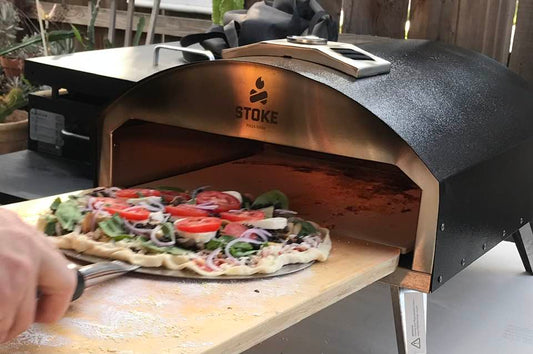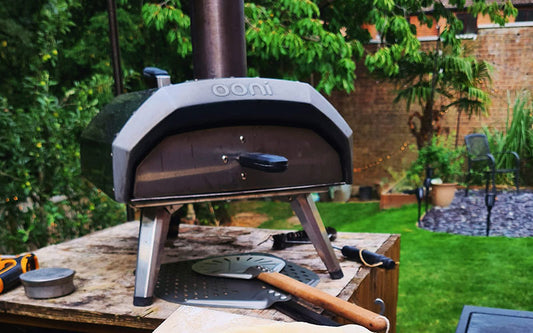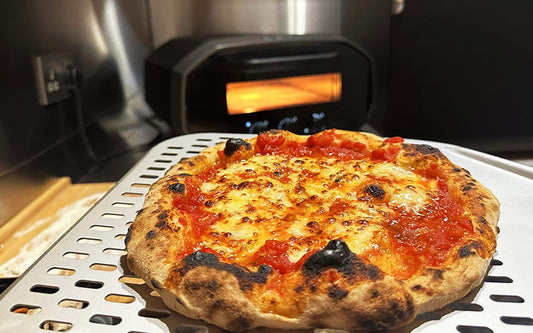How hot should a pizza oven be? That question comes up a lot, and it’s not as simple as you might think. The best temp to cook pizza depends on what kind of oven you are using and what style of pizza you are making.
If you want to make pizza in your own home, then you need to know what kind of oven will give you the results you’re looking for.
The style of pizza you want to make is also a key deciding factor. Neapolitan-style pizzas need above 900, while NY-style pizzas are typically baked at around 550F.
In this article, I will cover the basics of pizza oven temperature. Do note that the temperatures I will mention aren’t set in stone. Every oven is different. So, you might have to tinker with the temp settings a couple of times to get the results you are looking for.
Why Is Pizza Cooked at Such a High Temperature?
People invest in specialized pizza ovens to obtain the high temperatures that regular ovens cannot achieve.
So, what’s the role of high oven temperature for pizza baking?

It helps to create a crispy crust with an even distribution of air bubbles. This is because the hot air inside the oven heats up water molecules in the dough and evaporates them quickly.
This causes steam to form and expand in all directions, pushing out excess moisture.

Pizzas baked at higher temperatures have a light and airy crust with large air pockets. The beautiful leopard spotting on a quintessential Neapolitan pizza results from the oven’s high heat.
Pizzas with an ultra-thick crust, which is meant to hold a lot of wet toppings at baked low and slow. That explains why Chicago-style deep-dish pizzas are baked at 400 F.
Baking at a lower temperature for a longer time results in a thicker crust and a softer, more doughy interior. 500-550F is the standard baking temperature for New York-style thin-crust pizzas.
It gives you an ultra-thin but firm crust that is crispy along the edges and soft and flexible in the middle.
Pizza Oven Temperature and Time Chart
The chart below shows the best temperature for baking pizza in different types of ovens. This should give you a tentative idea of what temperature to use in your own oven.

Note that these are only the optimal temperatures and cooking times. You can experiment with other temps and times if you want.
If you’re not sure what kind of pizza oven to buy, start with a simple rule:
To get the best results, choose an oven that has temperature control. If your pizza oven doesn’t have one, get yourself a good digital thermometer.
| Oven Type | Estimated Pizza Baking Temperature |
| Wood-fired oven | 800F-1000F |
| Gas oven | 700F-900F |
| Convection Oven | 450F-500F |
| Electric Oven | 500F-550F |
Pro Tips for Baking Temperature and Time for Pizza in Different Types of Ovens
You’ll have to experiment with your own oven to find the best temperature and time for you. In general, the lower the temperature and longer the time, the thicker and chewier your pizza will be. Whether it’s a good thing or not depends on your preferences.
If you frequently follow my blog, you already know that my heart screams for thin-crust pizzas with minimal toppings. I don’t like masking the crust’s taste with copious amounts of toppings. So a blazing high temperature and short baking time produce the perfect pizza for me.
Here are a few key tips for different types of ovens to give you a headstart:
Pizza in a Wood-fired Pizza Oven
Traditional wood-fired can reach temperatures of 900°F (482.2°C) or higher. It’s a different beast compared to the electric ovens we use at home. Therefore, you will have to be really careful so as not to burn your crust.
Here are some tips to achieve the perfect wood-fired pizza every single time:
- Use a baking stone or steel – These are heavy ceramic materials that help absorb heat quickly. They also ensure your crust doesn’t stick to the bottom of the oven floor and burn before it’s cooked through.
- Use two types of peel – one for prepping and launching the dough into the oven and another for rotating it. This is the key to preventing the pizza dough from sticking to the pizza peel.
- Use a generous amount of plain flour or semolina to dust the peel. A lot of people like to use cornmeal for the same as well. I don’t because I don’t like the grainy residue it leaves at the bottom of the crust. But this is totally up to you.
- At 900 degrees F, bake the pizza for one minute. Increase the baking time by 30 seconds max if it’s still slightly uncooked in the middle.
- Keep rotating the pizza 90 degrees every 20 seconds to avoid over-charring one side of the crust.
Pizza in a Convection Oven
A convection oven has a fan that circulates the hot air around the pizza, which allows it to cook faster and crisp up nicely. Here are a few things you can do to get the most out of your convection oven while baking pizza:
- Use a pizza crisper or perforated pizza pan for a puffier, crunchier crust or a pizza pan for a doughier crust. If you are going to make multiple pizzas back to back, opt for a pizza stone instead, thanks to its better heat retention ability. You won’t have to wait too long between pizzas.
- Preheat the oven to 450°F.
- Place the pizza on a baking sheet or pizza stone. If using a baking sheet, make sure it has low edges to allow for air circulation.
- Bake the pizza in the middle rack for 8-12 minutes, depending on the thickness of the crust and the toppings. Check the pizza after 8 minutes to see if it is done to your liking.
- If it’s still uncooked in the middle, rotate the pizza 180 degrees and cook for 2-3 more minutes.
- Check the pizza for doneness by inserting a thermometer into the center of the pizza. The temperature should read at least 185 degrees Fahrenheit. If you don’t have a thermometer, look for visual cues like melted cheese and browned edges.
Pizza in an Electric Oven

This is the conventional oven that most people have in their homes. Although not ideal for pizzeria-style pizzas, it can whip up nice and simple homemade pizzas and cook frozen pizzas just fine. Some pro tips to ensure you get the best results with your electric oven include:

- Preheat your oven for 25-30 minutes at max setting (between 425 and 450 degrees Fahrenheit) before you plan to bake the pizza. The oven needs to be really hot when you pop the dough into the oven.
- Bake the pizza for 8-15 minutes depending on the diameter and thickness of the pie. Thin crusts take 10 minutes tops, while pan pizzas can take 12-15 minutes.
- Use an aluminum pizza pan that has holes in the bottom. This will allow heat to circulate more evenly, which means a crisper crust and better browning on top.
- Place the pizza in the middle of the rack and rotate it every 5 minutes or so for even cooking. It’s baked when the cheese is melty and the crust is golden brown.
Pizza on a Gas Oven
Gas ovens are the closest you can get to a brick oven in your home, so they’re perfect for making pizza. In fact, many pizzerias use gas ovens because of their even heat distribution and ability to reach high temperatures quickly.
If you have a gas oven at home, these are some pro tips for making the best homemade pizza:
- Crank up your gas oven to at 800°F and bake for 1.5 minutes for the ideal crisp crust.
- For optimal results, use a pizza stone. It might heat longer to preheat fully, but the pizza will cook faster and more evenly, which means a crunchier crust.
- If you use a pizza pan or crisper instead, rotate the pizza halfway every few minutes for even browning.
- You can also use a cast iron, stainless steel, or carbon steel skillet to make pizza in a gas oven.
- Should you choose to use a skillet, be sure to oil it well with olive oil or butter before adding the dough. This will help prevent sticking and burning while cooking.
Oven Temperatures for Different Pizza Styles
As mentioned right at the beginning, the style of pizza you’re making is also a key deciding factor here. This section will highlight estimated baking temperatures for the most popular types of pizzas out there.
Use it as a reference point when making your own pizza at home or in your cafe.
Neapolitan-style Pizza
The formula for Neapolitan-style pizza is very simple. It’s made with a thin layer of sauce, mozzarella cheese, and fresh ingredients like basil leaves and garlic. The crust for this style should be puffy, light, and airy, coupled with a pleasant amount of chewiness.
The ideal temperature for baking a classic Neapolitan pizza is anywhere between the 800 and 1000F range. At such blazing hot temperatures, a 12-inch pie will take only about a minute or two to bake.
Ooni pizza ovens can heat up as high as 932 degrees, which is the closest a domestic oven can get to the brick ovens used in professional kitchens.
Additional Tips
- Rotate the pizza every 20-30 seconds for even baking.
- Use a preheated pizza stone for an evenly cooked crust with a hint of smoky flavor.
- If using a convection oven, preheat the oven to 450 to 550°F (the highest setting available) and bake for 8-10 minutes.
- If using a non-convection oven for the same, bake at 400 to 450°F for 10-15 minutes.
New York-style Pizza
Thin-crust New York-style pizzas are dressed with heavy toppings, unlike Neapolitan pizzas. This is why NY pizzas are baked at a temp range between 500-700 degrees F, or sometimes 800F for 8-12 minutes, in a coal or wood-fired oven.
This temperature range is ideal for drying out the crust, allowing you to pile heavy toppings without worrying about the pizza becoming soggy. If you are using an electric oven, choose the highest temp setting likely to be 550 degrees) for NY-style pie at home.
Additional Tips:
- If you are baking in convection mode, a 14-inch pizza will take 8-12 minutes to bake at 500 degrees.
- If you’re using a gas oven with no convection setting, bake at 450 degrees for 15 minutes at least or until the crust has browned to your desired level.
- For the best results, use pizza crisper for this style of pizza. Make sure to preheat it before placing the dough on it.
- Check for doneness level with a peel or pizza turning peel every 4 minutes.
Chicago Deep Dish Pizza
Unlike the previously mentioned pizza styles, Chicago-style deep dish pizzas need to be baked slow and low. No matter which oven you use, for a 12-inch pie, aim for a baking temperature of 450 degrees and bake for 25-30 minutes. For a 14-inch pizza in a 1.5-inch deep dish pan, bake for 35 minutes.
Additional Tips:
- If using a wood-fired oven for this, preheat your oven as usual, and then let it cool down to 450 degrees. Use an infrared thermometer for accuracy.
- In a gas, electric, or convection oven, place the pizza pan on the bottom rack for baking. This would allow the crust to cook thoroughly without overcooking the toppings.
- Once the pizza is baked, take it out of the oven and let it cool in the pan on a wire rack for 10 minutes before slicing.
- To ensure even cooking, rotate the pizza in the oven every 5-10 minutes
Frozen Pizza
You can use a microwave or an electric oven to cook a frozen pizza. If using a microwave, bake it at the highest setting for around 5-7 minutes for a standard 8-9 inch pie.
Additional Tips:
Preheat your regular, non-convection oven to 450°F-475°F or a convection oven to 425°F-450°F. Bake for 15-25 minutes or until it looks golden brown.
Right Temperature to Keep Your Pizza Warm
Pizza is best served hot, just out of the oven. But if you’re not going to eat it right away, you can keep it warm for a few hours. For instance, if you’re having a party and want to serve your guests fresh slices throughout the evening, do this:
Preheat your oven to 170°F-200°F for optimal pizza warming without drying.
Now pop the pizza box (given it’s in the box) onto the middle rack. This will keep the pizza warm for about 30 minutes.
If we are talking homemade pizzas, here’s what I usually do:
Wrap the individual portions in aluminum foil and pop them into the oven at 400 degrees for 5-8 minutes. This will warm the pizza and keep it from drying before serving it.
Right Temperature for Baking Calzone
Well, a calzone is technically a stuffed pizza, so it should be baked at the same temperature as regular pizza. However, calzones are often stuffed with meat, cheese, and veggies that require a longer baking time.
My Ooni Karu 16 takes about 4 minutes to bake a calzone with marinara, ricotta cheese, and sauteed mushrooms.
In conventional ovens, bake them at 450-500 degrees F for around 15 minutes or until brown and puffed up.
Here is a chart that shows the right temperature to keep your pizza warm:
| Temperature | Time | Notes |
|---|---|---|
| 170°F (77°C) | 1-2 hours | This is the ideal temperature for keeping pizza warm without drying it out. |
| 200°F (93°C) | 2-3 hours | This temperature will keep your pizza warm for a little longer, but it may start to dry out a bit. |
| 250°F (121°C) | 3-4 hours | This temperature will keep your pizza warm for the longest, but it may start to get dry and crispy. |
How To Achieve Perfect Oven Temperature For Pizza?
Preheating is the key to achieving a perfect oven temperature for pizza. You should preheat your oven for at least 15 minutes before putting the pizza in it. This will ensure that the air inside is hot enough to cook your pizza properly without burning it or leaving it undercooked.
Don’t forget to keep an eye on your food while baking, too. Depending on size and toppings, some pizzas may take less time than others.
If you are using a conventional oven, turn on the convection setting, if available, while baking pizza. This will help distribute the heat more evenly in the oven, resulting in even browning.
To eliminate the guesswork from the equation, use an infrared thermometer to measure the internal temperature of your pizza. This will help you determine how long to bake it and help prevent burnt or undercooked crusts.
How Do You Know When The Pizza Is Done?
Again, a thermometer is the only foolproof way to ascertain the doneness of your pizza. The internal temperature should ideally be between 200-205 degrees and not more than 210 degrees when you take it out of the oven.
If you don’t have a thermometer, simply use the good ol’ “watch test” method. The crust of a thoroughly cooked pizza should be golden brown and crispy, while the cheese should be melted and bubbling.
If you see any uncooked spots on the pizza, it means that it needs more time in the oven. If you notice light charring around the edge of the crust on a Neapolitan-style pizza, it’s usually a sign of a well-done pizza. Give yourself a pat on the back if you can achieve that.
In Conclusion
So, there you have it—a detailed overview of the basic principles of setting oven temperature for baking pizza. As stated earlier, the temperature will vary from oven to oven.
So, play around with different temp settings using this guide as a reference point. And let me know how it panned out for you in the comment section below.




